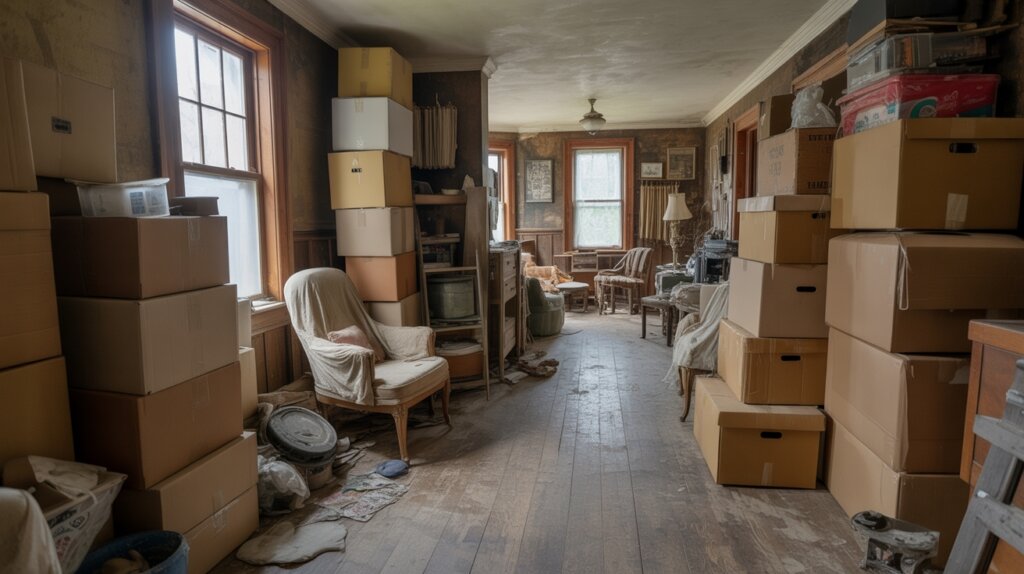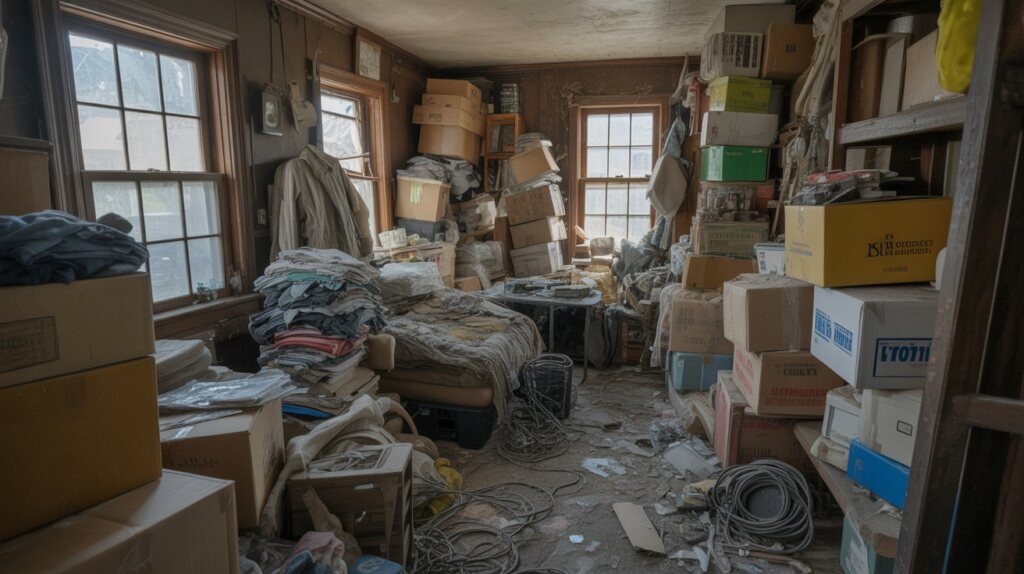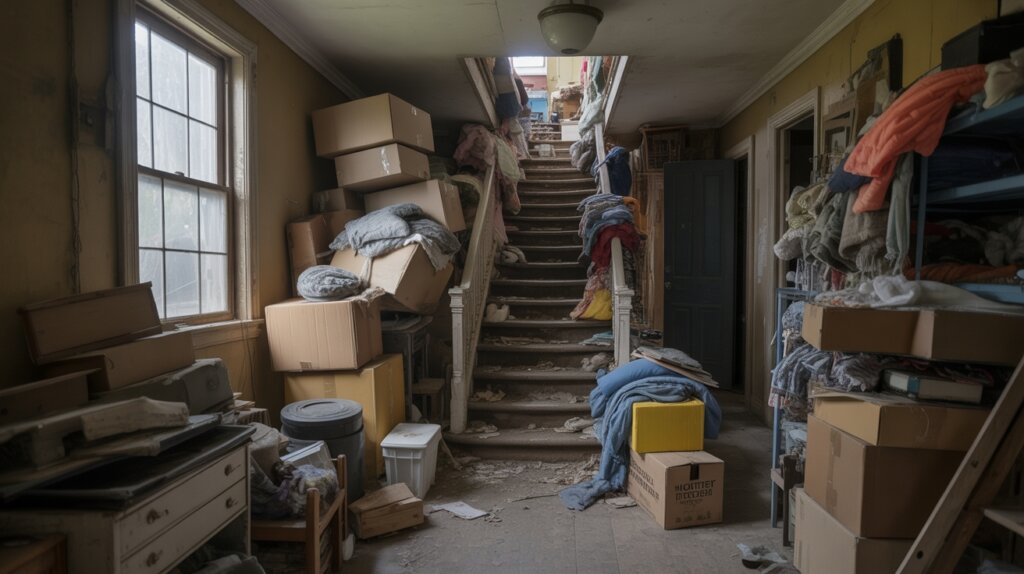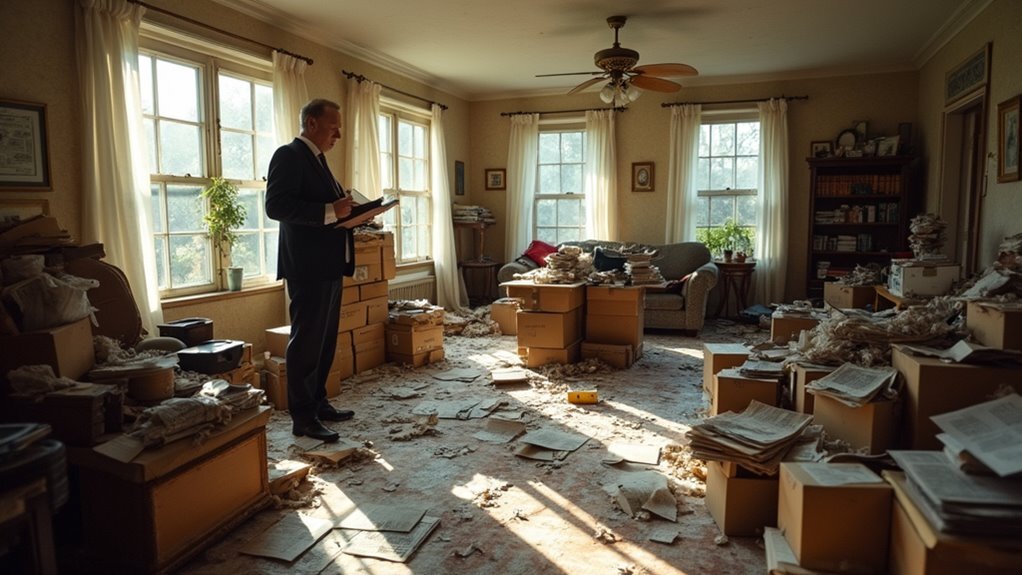Selling a hoarder house comes with real challenges. These homes often have clutter, neglect, or even damage. Many buyers will hesitate, and properties like these often take longer to sell.
The clutter can turn off most buyers and lower your offers. Photos may look unappealing, and showings can be stressful. You risk the house sitting unsold for months, losing value every day.
To market a hoarder house for sale, highlight its potential, use the right sales channels, and target motivated buyers. With the right approach, you can attract interest and move the property quickly. This blog will show you practical steps to solve this problem.
Key Takeaways
- Target investors and flippers by emphasizing structural integrity, renovation potential, and location over cosmetic issues in your marketing materials.
- Use honest listing descriptions with clear photos that highlight spacious layouts, unique features, and opportunities for transformation.
- Disclose all known issues and necessary repairs to build trust and attract serious, renovation-ready buyers.
- Advertise on specialized real estate platforms and social media groups focused on distressed or fixer-upper properties.
- Price the property competitively below market value, factoring in repair and cleanout costs, to generate strong investor interest.
Understanding the Challenges of Selling a Hoarder House

Selling a hoarder house is difficult because of too much clutter and hidden repair problems. Most buyers feel overwhelmed and may not see the home’s value. Limited access and safety issues can also turn people away. Too much clutter and hidden repairs in a hoarder house can overwhelm buyers and make it hard for them to see its value.
If a house looks cluttered, buyers may not picture it organized. You could show storage ideas to help them see its potential. Data shows 80% of buyers struggle with cluttered homes. Additionally, navigating liens can complicate the sale process if there are unresolved financial obligations tied to the property.
Some sellers feel attached to their belongings, which can make cleaning up hard. If that happens, suggest help from professional organizers or support groups. Sensitive communication is important in these cases.
Understanding how title insurance can protect sellers from undisclosed liens or legal defects may help ease some concerns about hidden issues or future claims. If you improve the home and talk respectfully, you can attract more buyers. A clean and organized home looks better in the market. These steps make selling the property easier.
Assessing the Property’s Current Condition
Assessing the property’s current condition means checking its real state before selling. You should walk through each room and take notes. Photos help show exactly what needs fixing or cleaning.
A professional should check for hidden problems in the structure. If the house has pests or damage, this step will reveal them. You can use this information to decide what repairs are needed.
You should also look at how much junk needs removal. Too much clutter can hide bigger issues. If you find serious problems, make a plan to address them.
Clear records and honest details build trust with buyers. If you know the facts, you can set a fair price. This approach helps you attract serious offers.
Additionally, conducting a thorough home valuation can help determine an accurate asking price and identify potential issues early on. Understanding the property’s market worth is essential for setting a fair and competitive price, which attracts more cash buyers and facilitates a smoother sale.
Deciding What to Clean and What to Leave

Start by tackling immediate safety hazards, as data shows these are buyers’ top concerns. Next, identify and save items with clear value, whether financial or sentimental. Focus your cleaning efforts on areas that will boost buyer appeal and make the home easier to stage.
Additionally, consider the current market value of the property to prioritize which areas may yield the most benefit when improved or cleared. Understanding the accurate market value assessment can help you decide where to focus your efforts for the best return.
Prioritizing Safety Hazards First
When cleaning a hoarder house, always fix the most serious safety hazards first. These issues can affect health and cause legal problems. If you ignore them, the risks increase.
Start by removing hazardous items, like chemicals, expired medicine, and biological waste. The Environmental Protection Agency says incorrect disposal of these can lead to high cleanup costs. Proper handling also helps you avoid legal trouble.
Next, check for structural dangers, such as weak floors or blocked exits. The National Fire Protection Association warns that blocked pathways raise fire risk. If you find these issues, fix them before cleaning anything else.
You should not focus on appearance until safety problems are solved. Repairs and proper cleanup make the house safer for everyone. This also helps attract buyers and pass inspections.
Salvaging Valuable Items
Salvaging valuable items means finding things worth keeping or selling in a hoarder house. Some items can be sold, donated, or kept for memories. A careful search helps you spot these valuable things.
If you see antique furniture, check its condition first. Good pieces can be restored and sold for a high price. Even old or dusty furniture might be valuable after cleaning.
Collectibles like coins, stamps, or memorabilia may have hidden worth. These items can attract collectors if they are in fair shape. Always set them aside for a closer look.
Functional appliances are worth saving if they still work. These can be sold or donated to people who need them. Make sure each appliance is safe and clean before offering it to others.
Staging for Buyer Appeal
Staging helps buyers see a hoarder house’s value. You should clear clutter from kitchens, bathrooms, and living rooms first. These rooms strongly affect a buyer’s choice.
Clean all visible surfaces and keep walkways open to create a spacious look. Neutral furniture can show buyers how each room might look. If you cannot clean everything, focus on the most-used spaces.
Decluttering can be hard for previous owners or families. Offer support if they feel stressed or overwhelmed. Balanced cleaning and smart staging can increase buyer interest and raise offers.
Determining the Target Buyer for Your Hoarder House

You need to focus on investors and flippers, since 85% of distressed property buyers fall into these categories. They’re looking for properties with promising value, not perfection, so highlight structural soundness and location over cosmetic flaws. By understanding what attracts these buyers, you’ll position your hoarder house for a faster, more profitable sale.
Additionally, understanding how to disclose title issues can help build trust and facilitate smoother negotiations with cash buyers. Being aware of common selling pitfalls, such as overpricing or inadequate preparation, will also ensure you avoid delays and maximize your property’s appeal.
Identifying Investor Interest
Investors are the most likely buyers for hoarder houses. They look for properties with low prices and high potential. If you want to find them, start by checking recent sales of fixer-uppers in your area.
Marketing should focus on investor websites and online groups. Use honest photos that show both problems and possibilities. If needed, highlight key areas like the kitchen or the house’s structure.
Listings labeled as “fixer-upper” often get more attention from investors. Direct mail to local investor groups can bring higher response rates. Online ads aimed at “cash buyers” attract motivated leads.
These steps will help you reach buyers who understand the value in challenging properties. If you use these methods, you will attract serious and knowledgeable investors.
Appealing to Flippers
Flippers are buyers who look for homes they can fix and sell for a profit. If you want to attract flippers, focus your marketing on investment potential. Flippers are interested in numbers, so show them how much they could make.
Use digital ads to highlight the property’s value after repairs. Show clear before and after photos to prove how much the home can change. If you do this, flippers will see the opportunity right away.
Target real estate groups and forums on social media. These places help you reach serious flippers quickly. If you use these strategies, your hoarder house will stand out as a strong investment.
Setting a Realistic Asking Price
A realistic asking price reflects the true market value of a hoarder house. Buyers expect to pay less for homes needing repairs or cleanup. You should compare your property to similar distressed homes in your area. Considering the extent of damage and repairs needed can help you set a more accurate price. If you set the price slightly below market value, you can attract investors.
Do not price it too low, or you may lose negotiating power. Always consider the costs buyers will face, like junk removal and repairs. A good price signals value and opportunity, not desperation. Utilizing market data instead of only looking at perfect homes can provide a clearer picture of your property’s worth. Strategic pricing helps you get serious offers from buyers.
Highlighting the Property’s Potential Value
You’ll attract more buyers when you spotlight the renovation opportunities a hoarder house offers. Point out solid structural elements, spacious layouts, or unique architectural details that add long-term value. By focusing on these core features, you help buyers see past clutter and recognize the property’s true powerful potential.
Additionally, emphasizing property title issues and the importance of proper legal standing can reassure buyers about the legitimacy of the sale. Highlighting financial benefits of downsizing, such as unlocking home equity or reducing ongoing expenses, can further motivate buyers to see the property’s potential as a smart investment.
Emphasize Renovation Opportunities
Renovation opportunities are a key benefit when buying a hoarder house. Buyers can often create value by updating and improving the space. These homes can become profitable investments with the right renovations.
A hoarder house offers a blank canvas for custom upgrades. If you remove clutter and add modern storage, the home gains new appeal. Simple updates can increase the home’s value quickly.
Buyers can picture an open kitchen by clearing out old items and installing new cabinets. A finished basement with better storage can add usable space. Bathrooms can look modern with fresh finishes and smart organization.
If you focus on these renovation ideas, you can attract buyers looking for value. Renovated homes often have a strong return on investment. Highlight these possibilities to help buyers imagine the potential.
Showcase Underlying Property Features
Buyers should focus on the main features that give the property its real value. Key selling points include square footage, natural light, and solid construction. Unique architectural details also add to the home’s appeal.
Spacious rooms and flexible layouts are important to many buyers. These features often matter more than any surface clutter. Data on similar homes and neighborhood trends can show the property’s true potential.
Effective storage is a must for organized living. Built-in cabinets, large closets, and attic space can help keep things tidy. If buyers want a smart investment, they should see how clutter can be managed with the right solutions.
Disclosing the Home’s Condition Honestly
Honest disclosure is important when selling a hoarder house. It reduces legal risks and helps buyers trust your information. Buyers are more likely to proceed if they believe what you say about the home. Additionally, setting a reasonable price can attract more potential buyers and facilitate a quicker sale.
Sellers should list any structural or safety issues found by inspectors. They should also mention rooms with heavy clutter that could hide problems. If some areas need major repairs, this should be explained clearly. Giving accurate details helps buyers understand the work required. It can attract buyers who are ready for a renovation project. If you are upfront, you can avoid surprises and make the sale process smoother.
Staging Strategies for Hoarder Houses
Focus your efforts on staging the home’s most important spaces—like the living room, kitchen, and primary bedroom—since these areas influence 80% of buyers’ decisions. Use minimalist decor to create an open, inviting atmosphere that helps buyers visualize the home’s potential. By prioritizing and simplifying, you’ll maximize appeal without overwhelming your resources.
Additionally, emphasizing these key areas can help you decide when to sell your house to a cash buyer, especially if you need a quick sale due to urgent circumstances. Being transparent about any title issues upfront can also streamline the selling process and attract serious cash buyers.
Prioritizing Key Living Areas
You should focus on the main living areas when preparing a hoarder house for sale. Buyers pay the most attention to the living room, kitchen, and main bedroom. These rooms affect their decision to buy.
Start by clearing counters and furniture to show more space. Next, arrange furniture to make paths clear and easy to walk through. Clean windows and surfaces so natural light makes the rooms look brighter.
If you prioritize these spaces, your house can sell faster and for a better price. Emotional attachment should not guide your choices. Always look at each room as a buyer would.
Minimalist Decor Techniques
Minimalist decor techniques help make a hoarder house more attractive to buyers. Clean, open spaces allow buyers to imagine living there. If a home looks uncluttered, it will likely feel larger and more welcoming.
A simple color palette with whites, grays, or earth tones creates a calm atmosphere. Vintage furniture with clean lines adds character if used in moderation. Artistic decor should be limited to one statement piece to avoid crowding the room.
Every item in the room should serve a purpose. Removing extra objects keeps the focus on quality rather than quantity. Buyers can better appreciate a home’s potential if they see only what is necessary.
Taking Effective Photos and Videos
Photos and videos are important for selling a hoarder house. Good visuals help buyers see the property’s potential and ignore clutter. If you use the right techniques, you can attract more buyer interest.
Furniture should be arranged to open up the rooms. Natural light works best, but soft artificial light can help if needed. If rooms are well-lit and staged, more people will look at your listing.
You should use wide-angle shots to show whole rooms and make spaces look bigger. Deliberate camera angles can highlight good features and hide problem areas. If you shoot at the same time of day, you will get even lighting and consistent colors.
Writing a Compelling Listing Description
A strong listing description helps buyers see the property’s true potential. Unique features and options for customization should be highlighted first. Buyers can quickly decide if the home meets their needs.
Spacious layouts and ample natural light are important selling points. Mention the large yard and landscaping possibilities, as curb appeal matters to most buyers. If buyers want to personalize a home, a blank canvas is valuable.
Home condition should be described honestly. If the property needs updates, explain the possibilities for creative improvements. Action words like “imagine” or “transform” help buyers picture their own changes.
Location details, such as nearby schools and amenities, should also be included. Buyers want to know about the neighborhood. A clear, honest description builds trust and attracts those ready to renovate.
Choosing the Right Marketing Channels
The right marketing channels help you sell a hoarder house faster. If you use targeted platforms, you can attract serious buyers. Investors and renovators often look for these types of properties.
Digital advertising is useful for reaching local buyers and investors. You can use platforms like Google Ads and Facebook Ads. These tools let you focus on specific areas and buyer types.
Social media helps you share photos and updates with many people. Instagram and Facebook are great for showing before-and-after images. If you post updates, you may get more interest.
Specialized real estate websites attract buyers looking for distressed properties. Listing your house here connects you with investors. You may sell quicker if you use these sites.
Working With Real Estate Agents Experienced in Distressed Properties
Working with a real estate agent who knows about distressed properties can help you sell a hoarder house faster. These agents have experience with similar homes and know what buyers want. They can guide you through each step of the selling process. A real estate agent experienced with distressed properties can speed up the sale of your hoarder house and guide you through every step.
Experienced agents use special marketing methods to attract the right buyers. They study local sales and suggest the best ways to show your house. If you follow their advice, you may increase interest from investors and renovators.
Agents can also recommend storage solutions to improve the look and feel of your home. They help set up cleaning schedules that make the process less stressful. This can make your home more appealing and ready for showings.
Relying on their knowledge can make the sale easier and potentially raise your selling price. If you want the best result, consider teaming up with an agent who specializes in distressed homes.
Handling Inquiries and Property Showings
Handling inquiries and property showings for a hoarder house needs clear planning. Sellers should give honest information about the property’s condition. This helps manage buyer expectations and saves time for everyone.
Listings must mention any key improvements, like cleaned garages. Buyers value honesty and visible progress. If buyers know what to expect, they are more likely to be interested.
If the neighborhood is concerned, sellers should explain steps taken to keep the area tidy. Clear communication about curb appeal can ease neighbor worries. This approach also reassures buyers.
During showings, organized spaces build buyer confidence. Showings should be scheduled in daylight for better views and safety. Sellers must answer questions clearly and provide full disclosures.
If sellers follow these steps, showings will be more successful. This also helps buyers trust the selling process. Simple strategies make the experience easier for everyone.
Negotiating Offers and Closing the Sale
Negotiating offers and closing the sale requires careful preparation. Hoarder houses usually attract buyers who want a lower price. You should expect negotiations to center on the home’s condition and repair costs.
Set your asking price using local sales data and repair estimates. If you have inspection reports or contractor bids, use them to explain your price. These documents help you respond to low offers with facts.
If buyers question your price, highlight the property’s possible value after repairs. Point out how quickly you can close the sale. Fast closings can be attractive to investors who want a simple transaction.
Be ready with all paperwork to avoid delays. Offer some flexibility to meet the buyer’s needs if they are reasonable. Your careful planning can help you get the best possible deal.
Conclusion
If you want to sell a hoarder house, you must highlight its potential and target the right buyers. If you work with professionals, you can make the process smoother and attract more interest. If you price your house competitively, you may speed up the sale.
If you need to sell your house quickly, we buy houses for cash in any condition. If you work with us, you do not need to worry about repairs or cleaning. If you choose this route, you can save time and avoid stress.
If you are ready to sell your hoarder house, we are here to help. We at Greg Buys Houses can give you a fair cash offer. Contact us today to get started.

